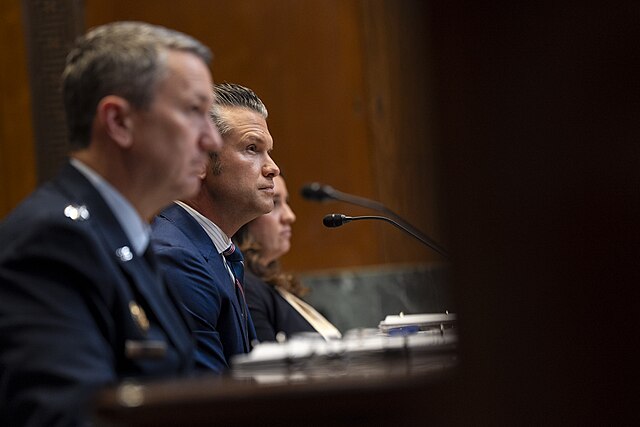It’s been quite the week for Pete Hegseth. In the past few days, he faced lawmakers on the Hill for the first time since becoming SecDef to defend a $1T DoD budget request that, well, he hasn’t released. Then, the House went ahead and released their appropriations bill, his procurement budget was leaked, and he had to face a whole new slew of questions.
Oh yeah, and there was the whole “sending the Marines to LA” thing. Impressive couple of days, honestly.
Hegseth on the Hill: Let’s start with the House hearing Tuesday. As could be expected after, well, the past six months, lawmakers had questions.
- Hegseth appeared next to Joint Chiefs Chairman Dan ‘Razin’ Caine before the House Appropriations Subcommittee on Defense.
- Fiery clashes erupted over the deployment of troops to LA and the potential invocation of the Insurrection Act by President Trump.
- Lawmakers mostly focused on the eyewatering $1T in funding for the DoD laid out in Trump’s FY26 budget request—not least because the Pentagon has not specified what exactly they’re asking for.
Rep. Rosa DeLauro (D-CT) did not appear particularly happy with Hegseth. “We don’t have anything today. We have zip, nada, [about] knowing where you’re going,” she said.
But not to worry: We now have slightly more than “zip, nada.” In a plot twist, the committee went ahead and released their draft appropriations bill after the hearing, keeping DoD funding flat at $831.5B (the same as FY25), with procurement at $174B.
But then (classic) a copy of the Pentagon’s planned $205B procurement budget was leaked, shedding light on the fun party trick that gets them to $1T:
- Of that $205B—up 18%—$51B is dependent on Trump’s ‘Big Beautiful Bill’ surviving the reconciliation process. If it passes (perhaps helped by the president and a certain centibillionaire’s own reconciliation), we’re past the $1T mark.
- As SASC Chairman Roger Wicker has pointed out, the OMB isn’t, in fact, requesting $1T for the budget. It’s actually about $892.6B, with the remainder coming from the BBB.
Yesterday during Hegseth’s testimony before the Senate, Sen. Mitch McConnell called the administration’s push to pass defense spending in the reconciliation bill a “shell-game.” Wicker has said that OMB intends to “shred to the bone our military capabilities and our support to service members,” and accused the White House of trying to game the budget.
But anyway. Enough of the congressional drama. Save that for the baseball diamond. Let’s dive into the House’s draft appropriations, ‘cause that’s what we’ve got:
The classics:
- $8.5B for 69 F-35s.
- $1.2B for four E-2D Hawkeye aircraft to replace the aging E-3 Sentry—the Air Force’s Airborne Warning and Control System (AWACS) aircraft—and the proven-but-doomed E-7 Wedgetail.
- $37B for the procurement of 28 Navy ships, including a Columbia-class ballistic submarine, two Virginia-class submarines, and two DDG-51 destroyers.
The fun stuff: The committee also included $147B for RDT&E. Of that, the Air Force was the big winner with $51B, followed by the Navy with $27B, the Space Force with $19B, the Army with $13.5B, and $35B for other programs across the department.
The draft included:
- $3B for the Air Force’s Next Generation Air Dominance program, including the F-47
- $2.6B for hypersonics
- $198M for the Army’s Next Generation Combat Vehicle Technology
- A cool $508M for three MQ-25 unmanned carrier-based aircraft
- $1.3B in combined funding for DIU, APFIT, and OSC
- Cuts to Electronic Warfare and counter-UAS development
- Cuts to large unmanned surface vessels
- Cuts to small drones and counter-small drone tech
Off the Dome: While the Pentagon requested $25B in funding for the Golden Dome (iron is so 2011) missile defense program, that wasn’t explicitly in the House draft. Maybe that’s because, as Defense Appropriations Chair Rep. Ken Calvert (R-CA) told Hegseth, they “haven’t seen a clear definition of [it].”
The committee gave Hegseth 90 days after the NDAA’s enactment to provide a comprehensive plan that outlines the Golden Dome’s architecture, requirements, and implementation plan, pushing off its inclusion in the budget to FY2027 (sorry, Mr. President).
Build, baby, build: Fitting for the era of “factories of the future,” House defense appropriators proposed setting aside more than $132M for the creation of dual-use factories in a Civil Reserve Manufacturing Network (CRMN) to “rapidly scale weapons during wartime” and “manufacturing commercial goods during peacetime.”
They gave the DoD a year to submit plans for the first of these, adding to Hegseth’s very, very long list of to-dos.

